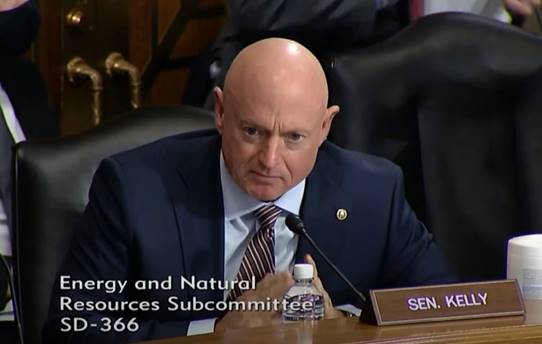WATCH: Sen. Kelly Speaks in Support of Arizona Land Transfer Legislation in La Paz, Yavapai Counties
Legislation would create solar jobs and support UArizona
Yesterday, in the Senate Subcommittee on Public Lands, Forests, & Mining, Arizona Senator Mark Kelly championed a pair of legislative proposals that would expand solar energy production and higher education in Arizona.
The first bill, the La Paz County Solar Energy and Job Creation Act, introduced by Senator Sinema and cosponsored by Kelly, would help La Paz County create renewable energy jobs through the completion of a proposed largescale solar farm west of Tonopah, Arizona.
“This is a critical next step to create good-paying renewable energy jobs in La Paz County, and I’ll continue working with my Senate colleagues and local leaders to bring economic opportunity to each corner of the state,” said Kelly.
“We’re continuing our efforts with La Paz County leaders to create good-paying Arizona jobs, boost affordable energy, and ensure La Paz County’s economy continues to grow. Today’s hearing is an important step to passing our bill into law,” said Sinema.

The second bill, the Arizona Experiment Station Land Conveyance Act, introduced by Senator Kelly and cosponsored by Senator Sinema, would transfer a 13 acre parcel of Forest Service land to the University of Arizona’s new School of Veterinary Sciences program. The land contains a ranch house adjacent to working ranch where students would stay while they learn how to care for cattle.
To watch Kelly’s full remarks, click HERE.
For a transcript of his remarks and exchange with the witness, see below:
[0:05]: Thank you, Mr. Chairman. Dr. Feldgus, thank you for your testimony on S. 528, the La Paz County Solar Energy and Job Creation Act.
Senator Sinema and I introduced this bill because it could lead to the largest solar project in the nation in terms of electricity production.
The bill would transfer 4,800 acres of land administered by the Bureau of Land Management to La Paz County to complete a proposed 1,500 megawatt PV solar facility that includes battery storage.
This is enough energy to power roughly 500,000 homes.
The La Paz project would tie into the proposed Ten West transmission line, which is designed to move renewable energy between Arizona and California.
Mr. Chairman, I ask unanimous consent to add to the record written testimony from La Paz County and the Colorado River Indian Tribe who support this legislation.
[Without objection.]
Dr. Feldgus, how would the 1,500 MW of solar capacity at La Paz compare to the total amount of solar capacity on BLM land today?
[1:28]: Well, right now, as of May, there are 37 solar projects that have been approved on BLM land with a total capacity of over 7,000 megawatts.
[1:35]: So this is a significant addition?
[1:37]: That … yes.
[1:39]: And how would you describe BLM’s track record on permitting solar projects?
[1:46]: Well, as part of President Biden’s goal to get to a carbon free electricity sector by 2035, and in support of the Energy Act of 2020’s goal of permitting 25 gigawatts of renewable energy on public lands by 2025, the Department and the Bureau of Land Management are taking steps to improve their permitting processes all the time, looking to make processes more efficient and effective for applicants and for local communities and improving consultation with tribes and taking into account all of the different factors that we need to on multiple use land. Just a few months ago, the Bureau of Land Management held some listening sessions to kick off the process of reviewing the renewable energy regulations, so we listened to a variety of stakeholders from across the spectrum, local communities, tribes, scientists, land owners, and we are currently in the process of working on new regulations to improve the efficiency of the process.
[2:44]: So is it your opinion that this transfer of land to La Paz county would be a more expeditious process?
[2:52]: Well, right now I understand there is a permit application for solar on those lands currently so we are concurrently moving that permit through the process while Congress considers legislation
[3:04]: Well thank you Dr. Feldgus.
Mr. French, thank you for your testimony today. I want to respond to the written testimony submitted by the Forest Service on my bill, S. 1631.
This bill would transfer 13 acres of Forest Service land to the University of Arizona for its new School of Veterinary Sciences program.
In its written testimony, the Forest Service says it opposes the bill over two issues that I would like to correct for the record.
The first is, the Forest Service is concerned that the University could sell this land to developers.
The bill, S.1631, is clear that land would revert back to the Forest Service if the University ever ceased to use it for the veterinary program.
Second, the Forest Service was concerned that the land would become an isolated parcel of private land inside Coconino National Forest.
Again, the bill is clear that the 13 acre parcel would not be a private inholding. It is a ranch house that is contiguous to an existing working ranch owned and operated by the University.
The ranch house is where students will live for several weeks as they learn how to care for livestock, so it is not isolated within the national forest. So, Mr. French, could you direct the leadership at Coconino National Forest to meet with the University of Arizona to clear up this misunderstanding about the bill?
[4:47]: Yeah, I’d be happy to.
[4:49]: Thank you, and I yield back.
